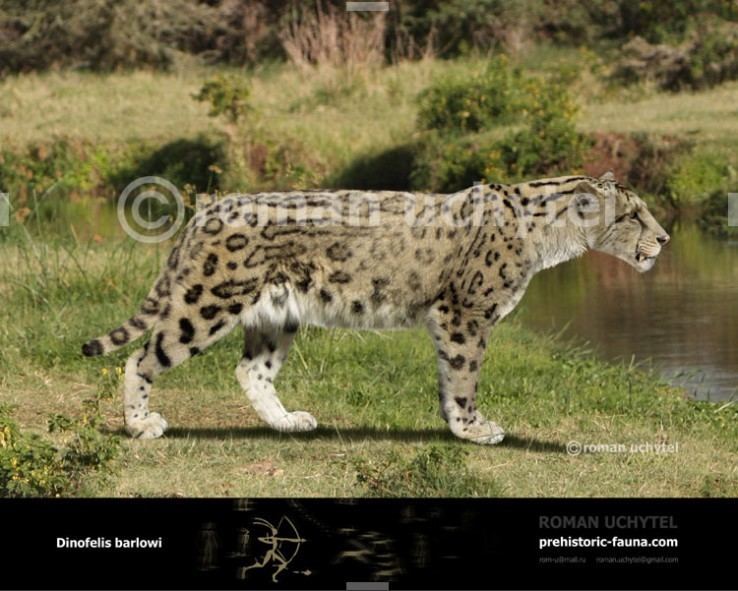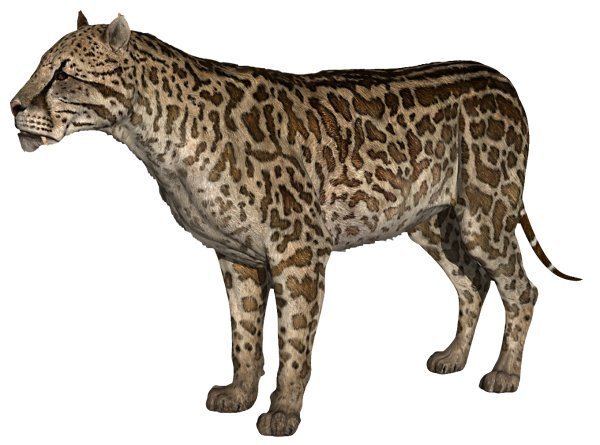Phylum Chordata Scientific name Dinofelis Rank Genus | ||
 | ||
Similar Megantereon, Homotherium, Felidae, Machairodus, Metailurus | ||
The sabertooth cat dinofelis barlowi reconstructed
Dinofelis is a genus of extinct sabre-toothed cats belonging to the tribe Metailurini. They were widespread in Europe, Asia, Africa and North America at least 5 million to about 1.2 million years ago (Early Pliocene to Early Pleistocene). Fossils very similar to Dinofelis from Lothagam range back to the Late Miocene, some 8 million years ago.
Contents
- The sabertooth cat dinofelis barlowi reconstructed
- Dinofelis cristata s search
- Description and ecology
- Paleobiology
- Taxonomy
- In popular culture
- References

Dinofelis cristata s search
Description and ecology

In size they were between a modern leopard and a lion, most being about the size of a jaguar (70 cm tall and up to 120 kg), medium-sized but powerful cats that possessed two prominent sabre teeth. The front limbs were particularly robust compared to the modern cats (even the jaguar).
Two specimens were examined by Serge Legendre and Claudia Roth for body mass. The first specimen was estimated to have a weight of 31.4 kg (69 lb). The second was estimated to have a weight of 87.8 kg (190 lb).
The canine teeth of Dinofelis are longer and more flattened than those of modern cats but less so than those of true saber-tooths. Dinofelis and nimravids are generally referred to as "false saber-tooth" cats because of this. (However, Nimravids are not close relatives of Dinofelis.) While the lower canines are robust, the cheek teeth are not nearly as robust as those of the lion and other modern big cats.
Based on Dinofelis' likely preference of forest habitats, it is believed by ethologist William Allen et al that Dinofelis possessed a spotted or striped coat of fur.
Paleobiology
This stout body may implicate a preference for dense or mixed habitats although it may also have been similar to the extant jaguar with its range from forest to open range including wetland.
Dinofelis likely hunted animals including, mammoth calves, young and old mastodons, Homo habilis (an ancestor of modern humans) and other animals. However, examination of Dinofelis's carbon isotope ratios indicates that Dinofelis at Swartkrans at least, probably were not hominid hunters, preferring to prey on grazing animals instead. The true hunters of hominids in the environment at that time were most likely leopards and fellow machairodont Megantereon, whose carbon isotope ratios indicated that they were more likely to be preying on hominids than Dinofelis.
Taxonomy
Dinofelis fossils and bones have been found in South Africa along with those of the baboons that it possibly killed. Bones from several specimens of Dinofelis and baboons were found in a natural trap. Dinofelis may have entered the place to feed on trapped animals or may have simply wandered into a location and was not able to escape again. Several fossils sites from South Africa seem to show that Dinofelis may have hunted and killed Australopithecus africanus since they harbored fossilized remains of Dinofelis, hominids, and other large contemporary animals of the period. Also, since Dinofelis remains have been found near Paranthropus fossil skulls in South Africa, a few of which have peculiar twin holes in their crania matching the Dinofelis upper canines's spacing almost exactly, it is possible that Dinofelis was preying on robust hominids as well. This may however been rare, as carbon isotope ratios indicate that Megantereon and leopards were more likely to have preyed on hominids and other primates, while Dinofelis preferred to hunt grazing animals.
It is thought that the gradual disappearance of the forests in which Dinofelis hunted may have contributed to its extinction at the start of the ice age.
Other undescribed species may exist.
Dinofelis paleoonca was named by Meade (1945). Its type locality is Meade's Quarry 11, which is in a Blancan terrestrial horizon in the Blanco Formation of Texas. It was recombined as Dinofelis palaeoonca by Kurten (1972), Hemmer (1973), Dalquest (1975), Kurten and Anderson (1980), Schultz (1990) and Werdelin and Lewis (2001).
In popular culture
Dinofelis appears in the BBC documentary Walking with Beasts, as a predator of Australopithecus.
The possibility of Dinofelis being a specialist killer of primates is briefly explored in Bruce Chatwin's The Songlines:
Could it be, one is tempted to ask, that Dinofelis was Our Beast? A Beast set aside from all the other Avatars of Hell? The Arch-Enemy who stalked us, stealthily and cunningly, wherever we went? But whom, in the end, we got the better of?
